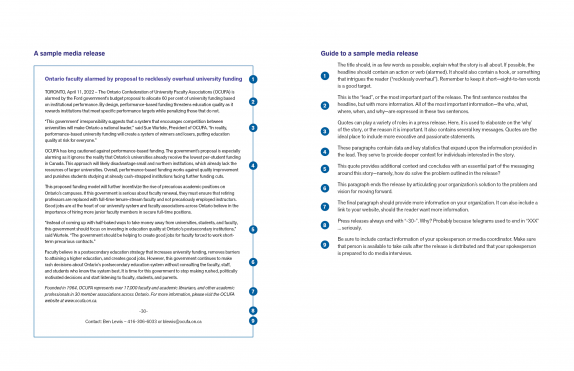Crafting a media release
Media releases provide news outlets and reporters with your messaging about an issue or event. Journalists will use them as sources of specific information and starting points for stories. A good release will alert media to the story, demonstrate its timeliness, summarize your position, and encourage reporters to investigate and follow up with you directly.
There are two types of media releases:
- A media advisory: Intended to notify reporters and editors about a specific event. They can also be used to indicate that your faculty association is available to comment on an issue or event (such as the release of a new report or the provincial budget). Media advisories are usually very short and released one to two days before the highlighted event.
- A general release: Intended to deliver your message on a given issue or event directly to reporters and editors. They contain your key messages, specific information on the story, several quotes from your representatives, and contact information. An effective general release both informs and engages media. It is a starting point for a conversation that, hopefully, results in positive coverage.
Distribution
Most media releases are distributed electronically. This can take several forms:
- E-mail: You can send the release directly to reporters in your community who are potentially interested in the story. It is useful to maintain a list of media contacts for this kind of distribution. If you have a relationship with a particular reporter or news outlet, they will be more likely to cover your story. OCUFA can help provide you with local media lists.
- Newswire services: These organizations distribute news releases widely, to local, regional, and national media. While efficient, they can also be expensive. If you think you have a story that is worth putting out on a newswire, OCUFA can help.
If your release concerns a specific event—such as a budget announcement or press conference—it is a good idea to bring printed copies of your release for distribution to reporters who attend.
Tips for a good media release
- Start strong: A good, punchy headline will capture interest and encourage journalists to read your release.
- Use the “inverted pyramid”: The most important information comes first, followed by supporting information. The who, what, where, when and why of the story should be in the first paragraph. Reporters are taught to write in this style, and using it allows you to “speak their language.”
- Avoid jargon or technical language: Your release should be written in a focused, conversational style that can be widely understood by a general audience.
- Keep it short and simple: The release should be focused on your key messages and be around 250–400 words. There should be around 5–7 short paragraphs of around 3–4 sentences. Reporters won’t read dense or overly long releases.
- Include some engaging quotes: Quotes allow you to personalize and humanize issues by attributing certain statements to an individual, usually the president of the organization or another key individual. Often, you can be more evocative in a quote than in other parts of the release. Quotes also help reporters put together a story. Journalists work on tight deadlines, often with little support. Having a couple of quotes makes it easier to put together an article if there isn’t time for interviews.
- Use the space strategically: Media releases are short, so make sure that every word counts. Each sentence should say something new and move the story along.
- Follow-up: Phone local reporters to make sure they received the release. This can help focus them on the story.
- Be persistent: Your release may not generate media coverage. But the next time you put a release out, reporters will be more familiar with your organization and your message.
- When the release in the story: For those in smaller cities and towns, local media are often looking for content and will sometimes reprint your media release in its entirety with a few tweaks. In lieu of a story, this is a good thing.
The structure of a good media release
Click on the image below to see a breakdown of the structure of a good release.




